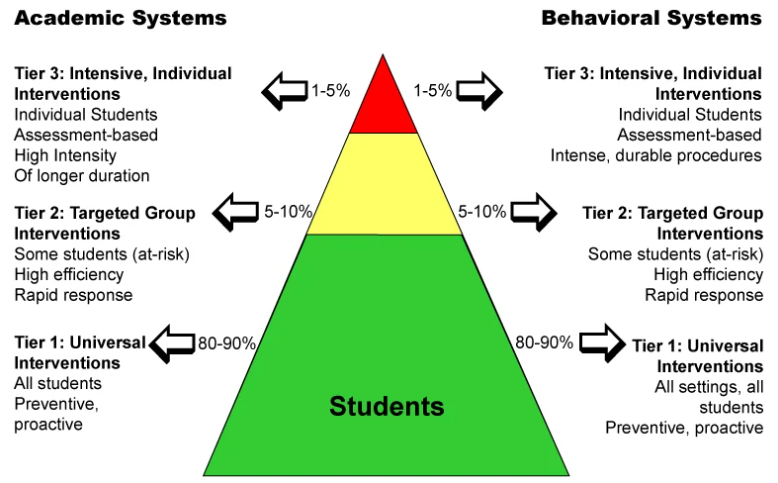Multi-Tiered System of Supports (MTSS)
Multi-Tiered System of Support
Introduction
At Attalla City Schools, our goal with the Multi-Tiered System of Supports (MTSS) is to ensure every student gets the help they need to succeed. MTSS is designed to identify students who are struggling early on and provide the proper support to get them back on track. This system offers a range of evidence-based interventions that increase in intensity as needed, ensuring that students always receive the level of support that works best for them. This document highlights the main elements of MTSS. It provides helpful guidance for our Problem-Solving Teams (PSTs) as they work together to track student progress, collect data, and determine the best interventions.
Key Elements of MTSS:
- A multi-tiered system that offers support at different levels
- Universal screening to identify students who may need extra help
- Ongoing monitoring to track how students are progressing
- Using data to make decisions about the best interventions for each student
MTSS is more than a standalone program; it's part of a more significant, ongoing effort to improve teaching and learning across all areas. We believe in proactively identifying issues before they become more critical problems. Focusing on prevention and early intervention ensures that students get the help they need right when needed.
What MTSS Looks Like in Attalla City Schools:
- Early Intervention: Instead of waiting for students to fall too far behind, we focus on identifying needs early on and addressing them right away. The earlier we act, the more successful we can be in helping students.
- Partnerships with Families and the Community: We understand that local school districts, families, and the community play a crucial role in making MTSS work. When everyone is working together, students get the full support they need.
- Overall Support: MTSS is about academics and the whole child. We address students’ academic, behavioral, social, and emotional needs to give them the well-rounded support that ensures long-term success.
- Teamwork: Teachers, counselors, and specialists collaborate to assess students’ needs and develop the best interventions. This team approach helps us create a comprehensive plan for each student.
- Parent Engagement: Parents are key partners in this process. We believe in keeping parents informed and involved because they play an essential role in supporting their child’s success at school and at home.
At Attalla City Schools, we’re committed to ensuring that all students get the support they need to succeed, no matter where they are in their learning journey. Each tier is designed to meet students exactly where they are and help them grow to their full potential.
Tier I: Core Instruction for Everyone
Tier I is the foundation of our approach to supporting students. This is the core instruction everyone gets, both academically and in social-emotional learning.. It’s designed to meet the needs of all students, with some differentiation to ensure every learner receives what they need. Students are expected to meet learning goals in Tier I, where most of the instruction happens (80%). It includes high-quality, evidence-based teaching that’s in line with state standards. The goal is for every student to meet grade-level expectations and be ready for the next steps in their education.
Tier II: Extra Support for Some
Tier II is for students who need extra help beyond the core instruction in Tier I. Around 10-15% of students might need additional supports delivered through small groups or more focused instruction. Teachers, and sometimes other specialists, will work with these students on specific skills they need to strengthen, whether academic or social-emotional. The extra support is based on the students' needs, and we use assessments to track their progress. Even though they get more help, students in Tier II continue with their regular Tier I lessons alongside their interventions.
Tier III: Intensive One-on-One Support
Tier III is for students who need the most intensive, individualized support. This might be due to significant academic or SEL struggles that can't be addressed through the previous tiers. Only a small percentage of students (around 1-5% need this help level.) The interventions are highly personalized at this stage, and specialists or counselors usually work closely with the students. Further assessments are done to understand students’ needs better and create a detailed plan to help them succeed. Additional evaluations, such as special education or Section 504 plans, may be considered if a student struggles.




 Additional settings for Safari Browser.
Additional settings for Safari Browser.


